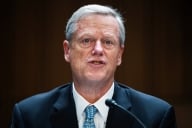You have /5 articles left.
Sign up for a free account or log in.

Max Page, a UMass faculty member, at a rally for public higher education
Invest in higher education in good times, drain it (and expect students and families to make up the difference) when the economy sours. State governments have embraced that pattern for decades, even as many analysts deride it as flawed if not foolish.
As most states set their budgets for the 2014 fiscal year this spring and early summer, public higher education fared better than it has in several years. The American Association of State Colleges and Universities reported last month that 37 of the 48 states for which it had received information showed year-over-year increases in operating support for public colleges and universities, with an average gain of 3.1 percent over 2012. That compared to 30 states showing increases from fiscal 2012 to 2013, and just eight on the plus side from 2011 to 2012. The fact that these increases come as college enrollments in many states actually begin to slow makes them all the more significant.
Particularly significant increases came in states such as Massachusetts (16.8 percent) and Washington (12 percent) where recent budgets have left public colleges struggling. (The positive picture is far from universal, of course; Louisiana subjected its public higher education system to yet another cut, of 17 percent, in 2014 and West Virginia and Wyoming imposed cuts of 5 percent or more.)
Legislators in many states purposefully accompanied those increases with frozen (or severely constrained) tuition, a clear response to the political and public pressure about the rising price of college, evidenced by President Obama's barnstorming tour on the issue this week.
The 2014 legislative successes should allow institutions in numerous states to offer raises for the first time in several years, and to continue (or in some cases begin) to reinvest in programs or initiatives that have been cut or put off over several bad budget years.
That is a much more pleasant climate for campus leaders to operate in than was the one that has prevailed in recent years. On the question of whether the funding upturn represents merely a return to the normal cycle of increases in good times and cuts in bad, higher education officials are hopeful -- if not quite confident -- that something more is at play: a recognition by political leaders that higher education is essential to drive individual and state economic success.
"This is first and foremost about improved economic conditions in the states," says Daniel J. Hurley, director of state relations and policy analysis at the state college association. "But there is some evidence that higher education has been prioritized to a higher degree than what current state conditions would have portended."
The Context
Few state-funded enterprises have fared particularly well in recent years, as 2008's downturn drove most state economies into a tailspin that exacerbated structural deficits that had plagued many of them for years previously. State funding for higher education fell for several years, and the situation was worsened by the fact that enrollments in many places grew, with funds failing to keep up. Funding per student reached historic lows in 2011.
Those trend lines raised concerns in many quarters about a perceived public disinvestment in higher education -- ironically, they often noted, at a time of growing recognition (rhetorically, at least) of the importance of postsecondary credentials for the economic success for individuals, states and the country.
The specter of disinvestment has been raised most frequently in places such as California, where legislators considered (but ultimately tabled) a plan that would have required state institutions to award academic credits for courses from third-party providers. Faculty and other groups noted in their pushback against the idea the irony that lawmakers were turning to outside providers to help solve a problem -- public colleges' inability to meet the higher ed demands of Californians -- created by the state's own failure to fund its institutions. Last November Californians approved a ballot measure that raised taxes to stem further cuts and allow for some reinvestment.
In that context, the turnaround in state revenues couldn't have come at a better time for state leaders and public college officials. This summer's report from the state college association found that while some states increased operating spending on higher education only marginally, many did in the 5-7 percent range, as seen in the table below.
And a report this month from the National Conference of State Legislatures showed that state general fund spending on higher education, on average, grew more than for any major category other than Medicaid -- 5.1 percent for higher education, compared to 5.9 percent for Medicaid, and 2.5 percent for elementary/secondary education and corrections.
Change in State Funding, Fiscal 2013 to 2014
| State |
% Change, FY2013 -FY2014 |
State |
% Change, FY2013 -FY2014 |
|
| Alabama | 1.8% | Montana | 8.7% | |
| Alaska | 3.6% | Nebraska | 4.0% | |
| Arizona | 4.1% | Nevada | 2.1% | |
| Arkansas | 1.6% | New Hampshire | 28.6% | |
| California | 5.0% | New Jersey | 0.0% | |
| Colorado | 4.4% | New York | 0.0% | |
| Connecticut | 4.8% | North Dakota | 10.7% | |
| Delaware | 3.4% | Ohio | 2.3% | |
| Florida | 11.0% | Oklahoma | 1.0% | |
| Georgia | 2.8% | Oregon | 7.0% | |
| Hawaii | 1.0% | Pennsylvania | 0.0% | |
| Idaho | 3.8% | Rhode Island | 6.4% | |
| Illinois | 0.2% | South Carolina | 3.0% | |
| Indiana | 3.1% | South Dakota | 7.5% | |
| Iowa | 2.6% | Tennessee | 7.8% | |
| Kansas | -3.3% | Texas | 6.2% | |
| Kentucky | 0.0% | Utah | 7.0% | |
| Louisiana | -17.6% | Vermont | 3.0% | |
| Maine | 0.0% | Virginia | 3.3% | |
| Maryland | 9.0% | Washington | 12.0% | |
| Massachusetts | 16.8% | West Virginia | -8.9% | |
| Michigan | 2.0% | Wisconsin | -2.9% | |
| Minnesota | 6.8% | Wyoming | -6.0% | |
| Missouri | -1.0% | 48 State Avg: | 3.1% |
Source: American Association of State Colleges and Universities
Some of the biggest gains came in states where higher education officials -- often joined by business leaders and faculty groups -- engaged in sustained, coordinated efforts to make the case for "investment in," rather than "spending on," higher education as a key driver of work force preparation, economic development, and general well-being in the state.
Lawmakers in Washington State in June approved a 12 percent increase in spending on public higher education, which college leaders hope will be the first step in reversing cuts that have seen the share of the cost of providing higher education fall from about two-thirds to just over a third.
Campus leaders like James L. Gaudino, president of Central Washington University, attributed the improved budgetary situation for public colleges to an upturn in the state's economic situation, which was better enough that legislators did not need to "squeeze" higher education to cover costs of other social programs as it has in the recent past.
"Clearly it's a sign that the economy is a little better -- that's the key," Gaudino said. But he also sensed a "dynamic" that is different from what he's seen in his five years in the state. "There has been a mentality that you feed higher education in good times because you can," he said, letting the negative corollary go without saying. "But we're now seeing a partnership among business leaders, government leaders and higher education that now realizes that if we don't invest in higher education, our economy won't be strong.... [State leaders] are starting to realize that this is really an investment, not unlike an investment in transportation infrastructure."
A Push for 50/50 Funding
Having watched the state's share of funding higher education slip to a third from two-thirds just a few years ago, some legislators in Washington State have pushed the idea of returning to a 50/50 split.
That goal underpinned the budget conversation across the country in Massachusetts this year, where higher education leaders -- joined in ways that they historically haven't been by a coalition of faculty, staff and student advocates -- persuaded politicians in the state to support a two-year plan to raise back up to 50 percent the share of public colleges' academic budgets covered by state funds (and concurrently lower to 50 percent the proportion covered by student tuition).
The 16.8 percent increase the legislature provided for the state's public colleges and universities -- two-year and four-year -- led the institutions to abandon or avoid tuition increases of about 5 percent, and the state's commitment of additional funds for next year should get the University of Massachusetts to the 50/50 goal, said its president, Robert L. Caret.
Like Gaudino, Caret said he believes the budget outcome in Massachusetts represents more than just a make-good on years of bad-times budgets.
"I see a tectonic shift in terms of legislative understanding of the need to invest in our citizens of the future," he said. UMass has spent the last few years proving that it is operating as cost-effectively as it can, Caret said, and that, combined with the campaign to herald higher ed's importance to the state economy, is now paying off.
Massachusetts provides at least some evidence that budgets for higher education aren't rising just because states are flusher than they've been; while the state's overall budget went up, funds for transportation were slashed (much to the dismay of city leaders), and money for higher education grew more than for most other purposes. So higher education was prioritized over other things, a phenomenon that the National Conference of State Legislators' report suggests was the case elsewhere, too.
Contributing mightily to the budgetary outcome in Massachusetts was the fact that after many years of fighting among themselves, faculty and staff leaders, college presidents, and other higher ed constituents did not engage in their usual "circular firing squad," said Max Page, a professor of architecture and history at UMass. Page, a vice president of the Public Higher Education Network of Massachusetts (PHENOM), an advocacy group, said the group's campaign to get institutional leaders, faculty and student groups, and others to "say the same darn thing at the same time" helped push higher education onto a list of priorities for new funding from which it was largely absent early in the legislative cycle.
That collaboration, if it can be replicated in future years, could, along with the enhanced sense of higher education's importance that Caret described, could mean that this year's budgetary outcome in Massachusetts might be the start of something different, Page said.
But given the history in Massachusetts and elsewhere, he added, "my inclination is to feel that the next time there's an economic downturn, they will just turn the spigot off to higher education, because they feel like they can always raise tuition."









